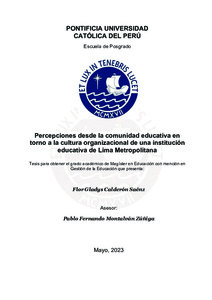| dc.contributor.advisor | Montalván Zúñiga, Pablo Fernando | |
| dc.contributor.author | Calderón Saénz, Flor Gladys | |
| dc.date.accessioned | 2023-07-31T22:50:08Z | |
| dc.date.available | 2023-07-31T22:50:08Z | |
| dc.date.created | 2023 | |
| dc.date.issued | 2023-07-31 | |
| dc.identifier.uri | http://hdl.handle.net/20.500.12404/25500 | |
| dc.description.abstract | La presente investigación tiene como objetivo estudiar las percepciones de
la comunidad educativa sobre los tipos y elementos de la cultura organizacional de
una institución educativa privada de Lima Metropolitana.
La metodología adopta un enfoque cualitativo y emplea el método de estudio
de caso único. La unidad de análisis está conformada por trece informantes y tres
documentos de gestión educativa (Proyecto Educativo Institucional, Plan anual de
Trabajo y Reglamento Interno). Los instrumentos utilizados para recopilar datos
fueron una entrevista semiestructurada y un análisis documental basado en una
matriz.
A partir de la presentación, análisis y discusión de los resultados se obtienen
los siguientes hallazgos. En primer lugar, el estudio reveló que dentro de una misma
organización educativa pueden coexistir hasta tres tipos de culturas, según la
relación entre las funciones de las personas y las actividades institucionales. Se
identificaron una cultura coordinada, donde los directivos y un equipo exclusivo de
profesionales tienen una participación decisiva; una cultura colaborativa,
caracterizada por la participación democrática de toda la comunidad educativa en
actividades extracurriculares; y una cultura fragmentada, con poca comunicación e
interacción entre los alumnos, docentes, coordinadores y directivos.
En segundo lugar, los elementos de la cultura organizacional describen el
contenido (infraestructura, normas y reglamentos, valores y creencias), la fuerza
(extensión o penetración, homogeneidad y claridad; que miden el nivel de
influencia, rigidez y adaptación en la organización) y la orientación (retrospectiva y
prospectiva; que indican el sentido histórico y lo que se espera lograr a futuro). En
cuanto al contenido, se destaca una infraestructura sólida, normas y valores que
promueven la responsabilidad, y creencias aceptadas por alumnos y padres de
familia; pero, la fuerza institucional es débil. Respecto a la orientación, prevalece
una perspectiva retrospectiva, enfocada en el pasado positivo del colegio hasta el
presente. | es_ES |
| dc.description.abstract | The purpose of this research is to analyze the perceptions of the educational
community regarding the types and elements of the organizational culture of a
private educational institution in Metropolitan Lima.
The methodology follows a qualitative approach and utilizes the single case
study method. The analysis unit consists of thirteen informants and three
educational management documents (Institutional Educational Project, Annual
Work Plan, and Internal Regulations). The data collection instruments employed
were a semi-structured interview guide and a document analysis matrix.
The presentation, analysis, and discussion of the results led to the following
findings. First, the study revealed that up to three types of cultures can coexist within
the same educational organization, depending on the relationship between the
functions of individuals and institutional activities. A coordinated culture was
identified, where managers and an exclusive team of professionals play a decisive
role; a collaborative culture, characterized by the democratic participation of the
entire educational community in extracurricular activities; and a fragmented culture,
with little communication and interaction between students, teachers, coordinators,
and managers.
Secondly, the elements of organizational culture describe the content
(infrastructure, rules and regulations, values, and beliefs), strength (extension or
penetration, homogeneity and clarity, which measure the level of influence, rigidity,
and adaptation in the organization), and orientation (retrospective and prospective,
which indicate the historical sense of the past and what is expected to be achieved
in the future). In terms of content, a solid infrastructure, norms, and values that
promote responsibility, and beliefs accepted by students and parents stand out.
However, overall institutional strength is weak. In terms of orientation, a
retrospective perspective prevails, focusing on the positive past of the school up to
the present. | es_ES |
| dc.language.iso | spa | es_ES |
| dc.publisher | Pontificia Universidad Católica del Perú | es_ES |
| dc.rights | info:eu-repo/semantics/openAccess | es_ES |
| dc.rights.uri | http://creativecommons.org/licenses/by-sa/2.5/pe/ | * |
| dc.subject | Gestión educativa | es_ES |
| dc.subject | Cultura corporativa--Estudio de casos | es_ES |
| dc.subject | Investigación cualitativa | es_ES |
| dc.title | Percepciones desde la comunidad educativa en torno a la cultura organizacional de una institución educativa de Lima Metropolitana | es_ES |
| dc.type | info:eu-repo/semantics/masterThesis | es_ES |
| thesis.degree.name | Maestro en Educación con mención en Gestión de la Educación | es_ES |
| thesis.degree.level | Maestría | es_ES |
| thesis.degree.grantor | Pontificia Universidad Católica del Perú. Escuela de Posgrado. | es_ES |
| thesis.degree.discipline | Educación con mención en Gestión de la Educación | es_ES |
| renati.advisor.dni | 42109103 | |
| renati.advisor.orcid | https://orcid.org/0000-0002-8577-1773 | es_ES |
| renati.author.dni | 08695980 | |
| renati.discipline | 191437 | es_ES |
| renati.juror | Sanchez Huarcaya, Alex Oswaldo | es_ES |
| renati.juror | Montalvan Zuñiga, Pablo Fernando | es_ES |
| renati.juror | Briceño Vela, Dany Marisol | es_ES |
| renati.level | https://purl.org/pe-repo/renati/level#maestro | es_ES |
| renati.type | https://purl.org/pe-repo/renati/type#tesis | es_ES |
| dc.publisher.country | PE | es_ES |
| dc.subject.ocde | https://purl.org/pe-repo/ocde/ford#5.03.01 | es_ES |







